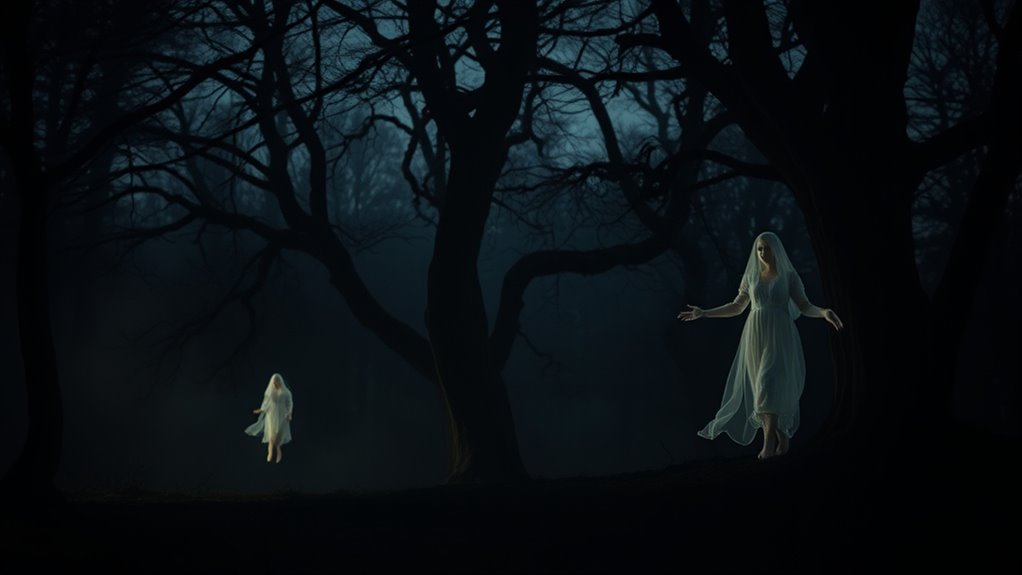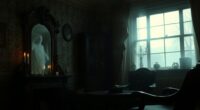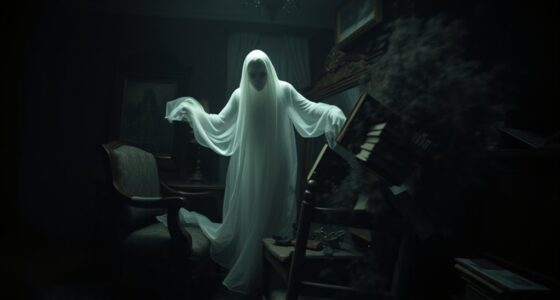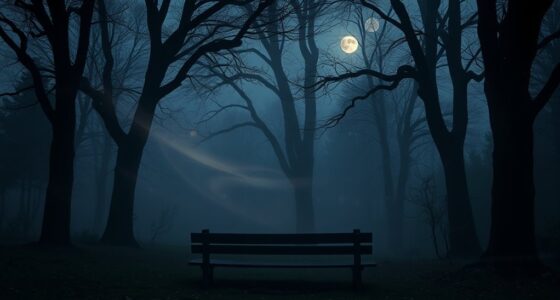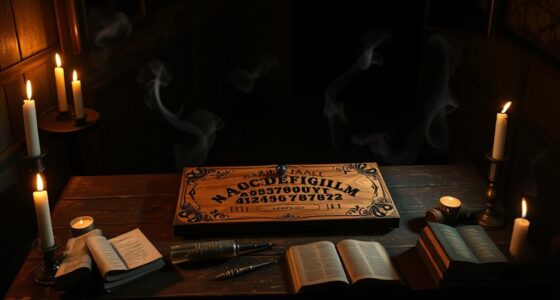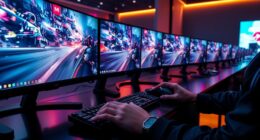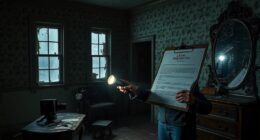While many cultures and individuals report ghost sightings, scientific evidence remains inconclusive. Investigations often find natural explanations like drafts, electrical interference, or psychological factors such as suggestion and fear. Personal experiences can feel real but are typically subject to bias or perception errors. Skeptics argue these stories are rooted in folklore or imagination. If you want to explore what evidence truly exists and what experts say, there’s more to uncover.
Key Takeaways
- Many ghost sightings are linked to folklore, psychological factors, and environmental influences, often lacking scientific proof.
- Scientific investigations use tools like EMF meters and cameras, but results typically explain phenomena without confirming spirits.
- Personal experiences are subjective and influenced by emotion, suggestion, and perception biases, making objective validation difficult.
- Skepticism emphasizes natural and psychological explanations, arguing that most paranormal claims lack empirical evidence.
- Cultural histories and reports suggest ghosts are part of collective consciousness, but conclusive scientific evidence remains absent.
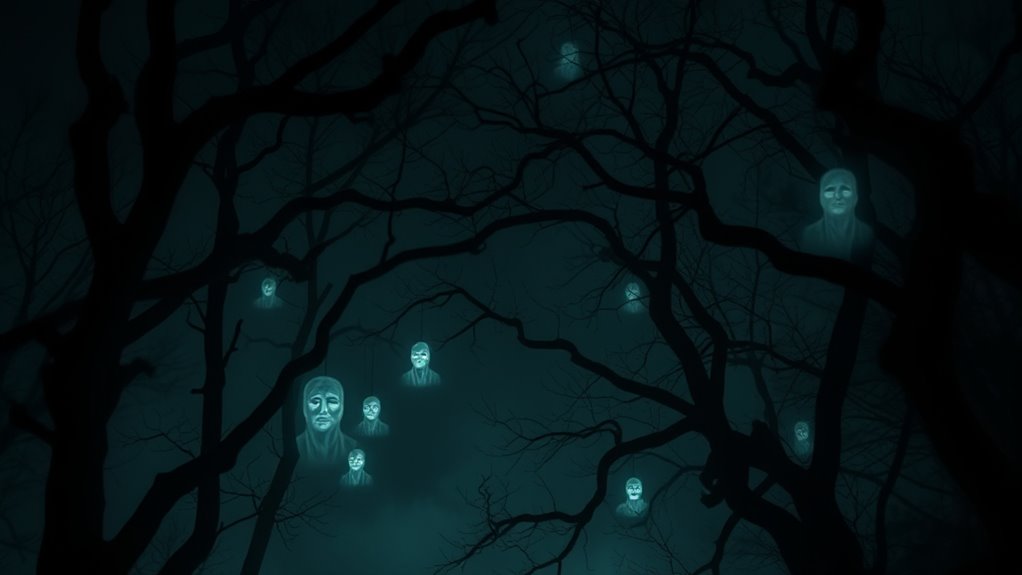
Many people wonder whether ghosts are real, sparking debates that blend science, folklore, and personal experiences. Over the years, numerous historical sightings have fueled the curiosity and skepticism surrounding these mysterious entities. From reports of apparitions in old castles to unexplained voices in abandoned buildings, these accounts often seem compelling. However, when you look at them through a scientific lens, many of these sightings can be explained by natural causes, misperceptions, or psychological factors. Skeptics argue that most ghost stories are rooted in superstition or the power of suggestion, especially since many incidents occur in environments associated with fear or grief. Despite this, believers point to the consistency of certain sightings across different cultures and eras as evidence that something beyond mere imagination might be at play.
Scientific skepticism plays a significant role in how we interpret these encounters. Researchers have tested various claims with tools like EMF meters, infrared cameras, and audio recorders. Although some recordings and images seem convincing, most fall under the category of pareidolia—our tendency to see patterns or faces where none exist—or are influenced by external factors such as drafts or electrical interference. These scientific investigations aim to separate fact from fiction, but they rarely provide conclusive proof of spirits’ existence. Instead, they often highlight the limitations of current technology and understanding when it comes to capturing paranormal phenomena. The skepticism isn’t dismissive of personal experiences but emphasizes the importance of empirical evidence in validating such claims.
Many of your encounters or stories might seem genuine, but without consistent, reproducible evidence, it’s difficult to move beyond anecdotal accounts. Ghost sightings tend to cluster around specific locations, especially those with a long history of tragedy or folklore, which can influence perceptions. Your mind, especially when primed by stories or emotional distress, can interpret ambiguous stimuli as supernatural. This doesn’t mean your experience isn’t real to you, but it does suggest that psychological factors play a significant role in how we perceive and remember these encounters. Understanding this helps you appreciate why many scientific investigations remain skeptical—they seek measurable, evidence-based explanations rather than relying solely on personal testimony.
Ultimately, whether ghosts are real depends on how you interpret the evidence. While historical sightings fuel the mystery, scientific skepticism urges caution and demands more rigorous proof. If you’re open-minded, you might see these stories as reflections of cultural fears and collective consciousness, rather than proof of an afterlife. If you lean towards skepticism, you’ll likely see most ghostly encounters as natural phenomena or psychological phenomena. Neither perspective dismisses personal experiences outright; both highlight the importance of critical thinking and scientific inquiry in exploring the unknown.
Frequently Asked Questions
What Scientific Methods Are Used to Study Ghosts?
You might wonder how scientists study ghosts, and they typically use paranormal instrumentation like EMF meters, infrared cameras, and audio recorders. These tools help detect unusual energy or sounds. Researchers follow strict experimental protocols to guarantee accurate results, often repeating tests in controlled environments. While these methods aim to gather evidence, they remain controversial and aren’t universally accepted in mainstream science.
Have Any Ghost Sightings Been Scientifically Verified?
Did you know that around 40% of Americans report seeing paranormal phenomena? While many claim to have witnessed ghosts, none have been scientifically verified under controlled conditions. Although ghost symbolism appears in various cultures, scientific studies haven’t confirmed actual sightings. You might feel convinced by personal stories, but the lack of empirical evidence keeps the question open. So, whether ghosts exist remains unproven by science today.
How Do Cultural Differences Influence Ghost Beliefs?
You’ll find that cultural differences heavily influence ghost beliefs, shaping how people interpret supernatural experiences. In some cultures, folklore traditions and cultural rituals involve spirits and ancestors, reinforcing the idea that ghosts are part of everyday life. These beliefs vary widely, with some viewing spirits as protectors, while others see them as warnings. Your understanding of ghost phenomena often depends on these cultural contexts, which deeply influence perceptions and stories about the supernatural.
Can Psychological Factors Explain Ghost Experiences?
You might find that psychological phenomena play a big role in ghost experiences. Your mind is influenced by cognitive biases, like pareidolia, which makes you see patterns or faces where none exist. Stress, sleep paralysis, and grief can also create vivid perceptions that feel real. These factors shape your experiences, making it easy to interpret ambiguous stimuli as supernatural, even when psychological explanations are more plausible.
Are There Technological Devices Capable of Detecting Ghosts?
You might wonder if technological devices can detect ghosts. Some experiments, like ectoplasm experiments and spirit communication tools, attempt to capture paranormal activity. Devices such as EMF meters, EVP recorders, and thermal cameras aim to identify signs of spirits. While these tools sometimes produce intriguing results, scientific consensus remains elusive. You should approach these technologies with curiosity, but also skepticism, recognizing that definitive proof of ghosts still eludes us.
Conclusion
As you stand at the crossroads of belief and doubt, ghosts become whispers in the wind—shadows dancing just beyond reach. The evidence is like a flickering lantern in the dark, sometimes illuminating, sometimes elusive. Whether they’re real or just echoes of our minds, you hold the lantern’s handle. The truth waits silently, like a gentle tide, inviting you to decide if you’ll follow its ebb or stay anchored in the shadows.
